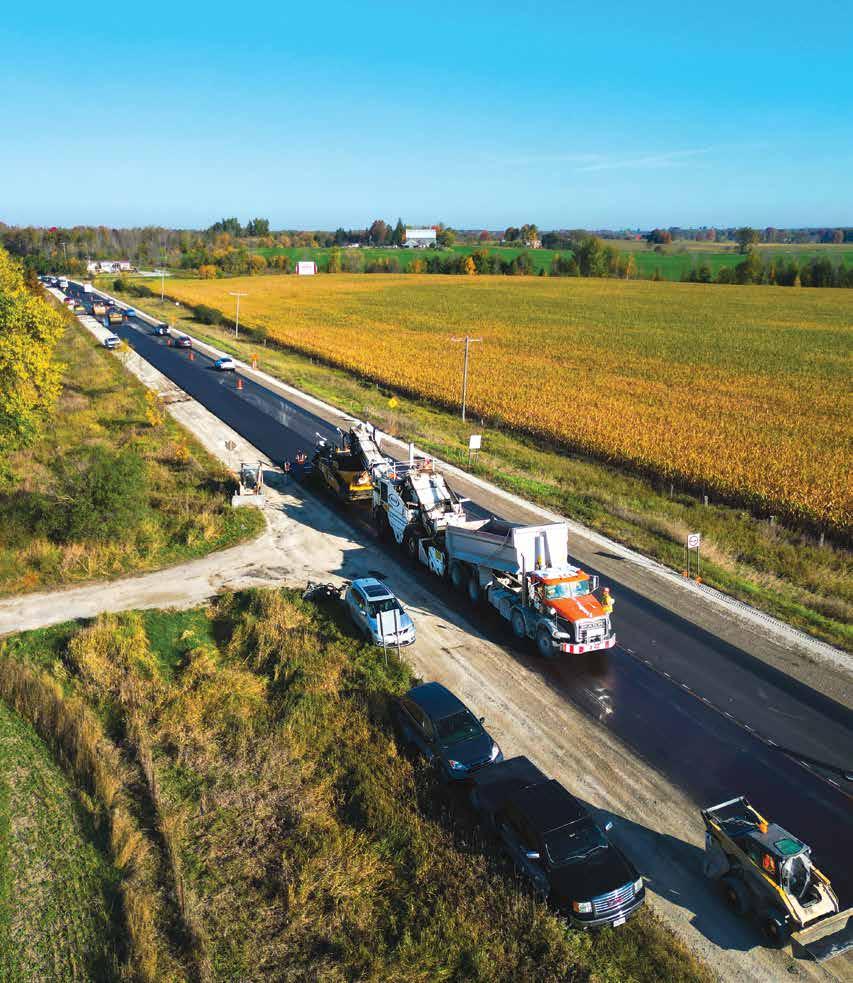
OAPC chair
SPRING 2024 | VOL37 | NO1
STEVE MANOLIS incoming
GLOBAL TRENDS asphalt sustainability AWARDS 2023
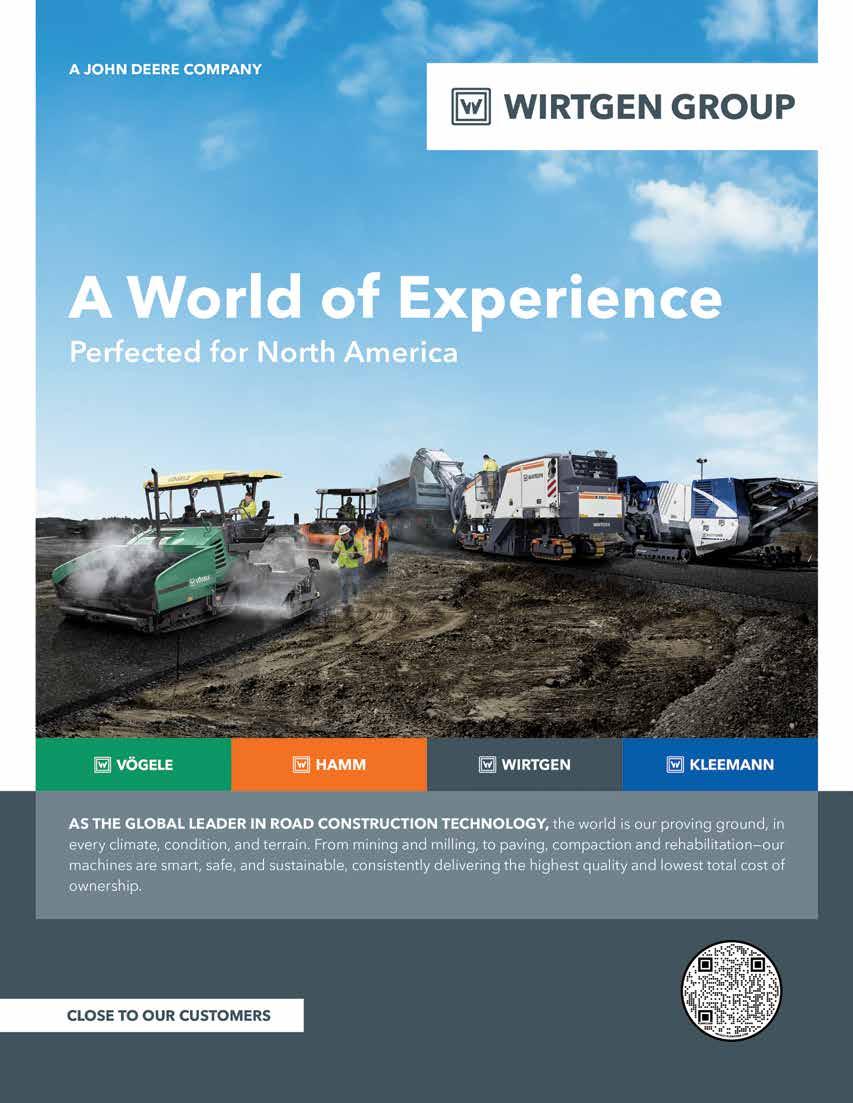
The
publication of the Ontario Asphalt Pavement Council, ASPHALTopics is
Ontario Asphalt Pavement Council
365 Brunel Road, Mississauga, ON, L4Z 1Z5
Tel: (905) 507-1107 • Fax: (905) 890-8122
Email: info@onasphalt.org
Website: www.onasphalt.org
Publications
Patricia Abbas | 416.438.7609 | pabbas8@gmail.com
Lara

official
published three times a year.
ADVERTISING SALES REPRESENTATIVE
Mail Agreement #40011181
EDITOR
Henry
& EDITORIAL LAYOUT pdplante.com
COVER PHOTO Hwy 7 from east of Slanted Rd to west limit of hamlet of Omemee (Dufferin Construction — A CRH Company). 05 Chair’s Corner 07 Operations Corner 09 MarCom Matters 10 Meet OAPC incoming chair Steve Manolis 14 Global trends in asphalt — sustainability 18 Trillium Award program winners 24 Screed plate innovation 28 Bleeds Black Award — Regan Cox 30 Poll results on attracting talent 32 Paver of the Year 33 Unsung Heroes 35 Technically Speaking 38 Environmental Essentials 40 Industry News 42 The Last Word TABLE OF CONTENTS SPRING 2024 3 © 2024 All Rights Reserved.
| larahenry@sympatico.ca DESIGN
inc. | pdominiqueplante@gmail.com


CHAIR’s CORNER
Peter Hamstra Chair
A year in review
2023 was a very busy and successful year for the Ontario Asphalt Pavement Council. We have reviewed and refreshed our strategic priorities and I can confidently say that we have once again made progress on all items. Our committees (where most of the heavy lifting is done) have been very active, focussing on their various agendas and supporting the overall vision and mission of OAPC.
The Plant and Paving Committee, chaired by Mike Deckert, once again delivered an excellent program at the popular Spring Operations Seminar. They are also the engine behind the Trillium Awards Program and the Road Scholarship Program among many others. Thank you to all the members of the Plant and Paving Committee for your outstanding accomplishments this past year.
The Marketing Committee, chaired by Kourtney Adamson, is the driving force behind our ASPHALTopics magazine, our website, and our brand identity as well as assisting with most of our key events throughout the year. The work they do keeps us connected with our industry partners and members which is critical to our success and we greatly appreciate their efforts.
Our HMA Technical Working Group chaired by Mark Latyn, and the OAPC-MTO HMA Committee chaired by Fernando Magisano, are tackling important topics such as quality, performance, specification reviews, sustainability and research along with other emerging technologies. They keep us at the forefront of all things technical in the asphalt industry. A big thank you to these committee members who are bringing a wealth of knowledge and huge value to OAPC.
The OAPC Environment Committee, chaired by Steve Manolis and vice-chaired by Christina Wright, is focussed on keeping ahead of changes in environmental regulations as well as updating the Environmental Practises Guide for asphalt plants among many other important items. This work is critical to our producer members as environmental compliance is essentially our license to operate.
Thank you to the committee members for the work you are doing on behalf of all members.
I also want to say a big thank you to Doubra Ambaiowei, our Director of Technical Services, who has a wealth of knowledge and experience in all these areas and works tirelessly to keep all our committees on track. He is the glue that holds us all together. His passion for advancing the vision and mission of OAPC is to be commended!
Our integration with the Ontario Road Builders’ Association (ORBA) has allowed us to operate as one united association on all fronts. From advocacy and research to education and communications, we have one strong voice to lead the industry forward. Led by our CEO Walid Abou-Hamde and the incredible staff, OAPC will continue to advance the cause of the asphalt paving industry in Ontario.
It’s hard to believe that my term as chair of OAPC has come to completion. As I reflect on the last 12 months, it has been a very rewarding experience. The opportunities I have had to connect with members and industry stakeholders across the province have been a highlight for me. A special thanks to the OAPC executive committee made up of Dominic Crupi, Steve Manolis, Chris Campbell and Walid Abou-Hamde for their support this past year. I am fully committed to supporting our new chair, Steve Manolis, during his term.
My final thought is to encourage all members and their employees to get involved in our great council in some way. Everyone has something to offer and we are stronger when we all participate.
Take care and stay safe.
SPRING 2024 5
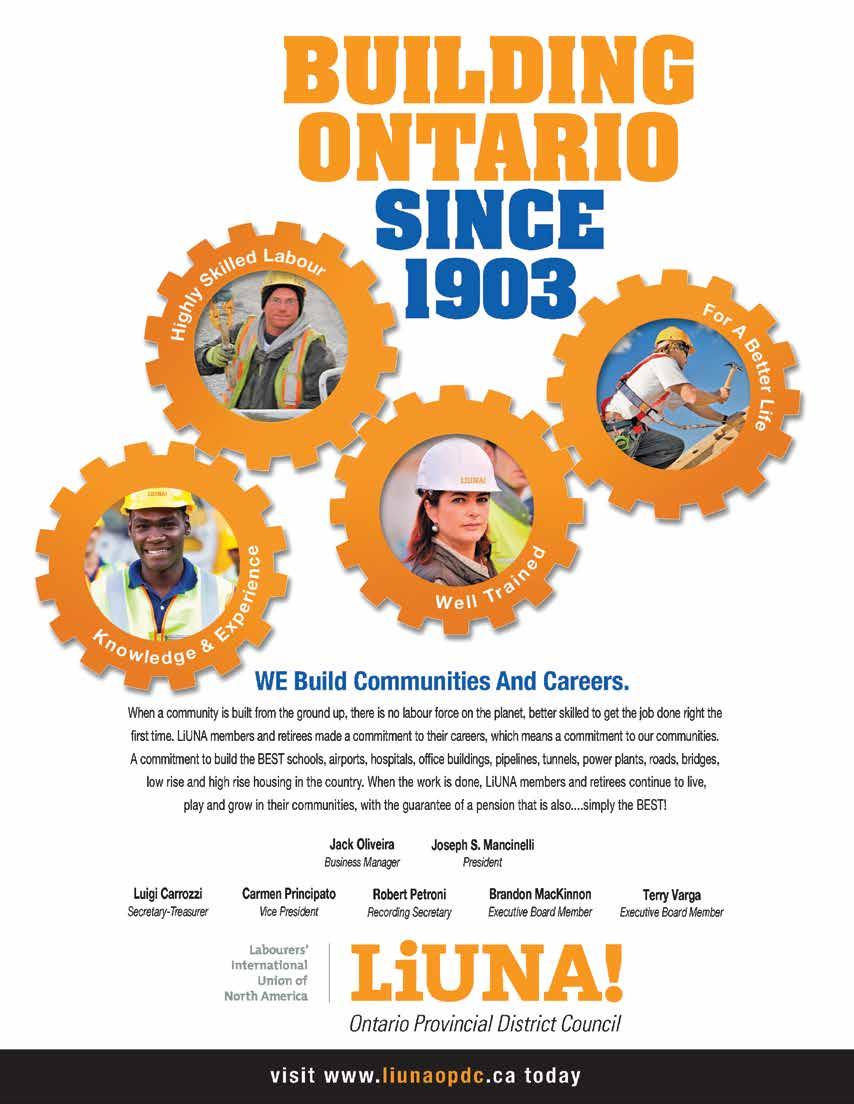

OPERATIONS CORNER
Doubra C. Ambaiowei Director, Technical Services
Another leap forward
Welcome to the spring edition of your favourite ASPHALTopics magazine! Just as spring ushers weather transitions from the cold of winter to the heat of summer, OAPC officially observed a transition in leadership as of the February 6th Annual General Meeting at the 2024 ORBA Convention. Steve Manolis, chair of the OAPC Environment Committee, officially took on the reigns of leadership as the council’s chair for 2024, including a seat on the ORBA Board of Directors.
The 2024 OAPC Executive Committee also hit an important milestone with Kourtney Adamson, chair of OAPC’s Marketing Committee, becoming the first female to serve as ExCo Secretary, and on route to chair in a couple years. Congratulations to the 2024 OAPC ExCo, and all returning and new directors to the council! To the outgoing 2023 ExCos and council directors, including exited directors – thank you for your service!
Operationally speaking, 2024 presents several opportunities for OAPC to advance on key opportunities around its strategic priorities of: Quality, Sustainability, Standards & Specifications, Research & Education, and Advocacy & Stakeholder Relations. We are continuing to leap forward on possible partnerships that will enhance our industry’s environmental and sustainability mandates, including important initiatives to improve our readiness for an era of performance testing in the contractual realm, while also encouraging and developing member proficiencies in Balanced Mix Design (BMD) implementation in Ontario.
We are also moving closer towards the application of Environmental Product Declarations (EPDs) for asphalt mixtures in Ontario. There is still a ton of work towards realizing this effort on EPDs with formal collaboration between the National Research Council Canada (NRC) and National Asphalt Pavement Association (NAPA) imminent –stay tuned for updates!
On April 11, we expect to see a large turn-out of the traditional plant and paving crew, including our typical Partners-in-Quality Road Tour audience, at the Spring Operations Seminar 2.0 to be held at the National Heavy Equipment Show (NHES) . The NHES is
a must-attend event at Mississauga’s International Centre bringing together the industry leaders in Canada’s heavy equipment, road building, construction, aggregates, crushing and screening and infrastructure sectors. Following the Spring Ops seminar, all seminar participants will enjoy complimentary admission to the show. The keynote presentation will feature a panel of industry experts and safety professionals who will review the top three hazards in asphalt production, placement, and general road building, with an emphasis on the shared responsibility of all workplace parties. Note that next year we plan to hold Spring Ops at two venues in Ontario.
On June 11, the Asphalt Technical Symposium (ATS) returns looking into the mandates and progress of the Ontario Asphalt Expert Technical Working Group (OAETG), as well as focusing on local solutions to local problems – approaches to Balanced Mix Design implementation in Ontario. Participation in the symposium is by invitation only, so if you are interested to participating, please let me and/or Chris Campbell (ATS co-chair) know ASAP. The ATS is a platform for education, unbiased discussions, and a vehicle that drives quality improvements for asphalt binders and mixtures produced and placed in Ontario. There is so much for OAPC to focus on these days including the council’s strategic priorities, the respective focus of the committees, continuing partnerships with external collaborators, and advocacy and stakeholder support initiatives to name a few. Through these efforts and the continuing support and commitment from the volunteering membership base, we cultivate opportunities to leap forward on the OAPC’s vision dedicated to quality and sustainable asphalt pavements in Ontario. As always, I look forward to hearing from you pertaining to all things asphalt. Do enjoy the spring activities and the contents of this issue of ASPHALTopics Thank you!
SPRING 2024 7


MARCOM MATTERS
Doubra C. Ambaiowei Director, Technical Services
OAPC’s commitment to the next generation of road builders
We know that the industry is facing a serious challenge in attracting and retaining talent, and it’s important to engage the next generation of road builders as they make their future career decisions. OAPC is bringing awareness of the asphalt industry to young people through a series of information sessions at colleges across the country, and through the Roads Scholarship Program (RSP).
During February and March, we conducted several sessions with student groups at various colleges, including heavy equipment operators at Fleming College, Lindsay Campus; technicians at Conestoga College, Guelph Campus; and students in the heavyduty equipment, power lift truck apprenticeship and motive power programs at Centennial College, Barrie Campus. Each of these sessions highlighted the opportunities and benefits of joining the asphalt and road-building industry as part of current and long-term strategies to attract and retain talent. We plan to continue similar sessions with students at Georgian, Algonquin and Canadore Colleges before the end of October 2024.
Many thanks to the respective OAPC-RSP college leads, OAPC’s Plant and Paving Committee members, and representatives from the council’s directorate who contributed their time and resources to ensure the completion of our RSP college presentations.
The Roads Scholarship Program was developed through OAPC’s Plant and Paving Operations Committee to better engage and
educate young people about the asphalt and road building industry as they are making career choices. Award recipients and select students are invited to OAPC’s Spring Operations Seminar free of charge and are formally recognized at the seminar. The program provides students with an excellent opportunity to learn more about the industry and to network with industry leaders.
Students who demonstrate exemplary leadership within their respective programs and who express an interest in the asphalt paving industry are selected by our partner colleges. The Roads Scholarship Program is a part of a long-term strategy to partner with local colleges from diverse regions of Ontario and increase awareness of the benefits of joining the industry and to promote training opportunities already. Students from each college are selected based on their academic achievement and exceptional leadership and technical skills. Special consideration for the scholarship is given to students who express a keen interest in the road building and asphalt industry.
Since 2013, OAPC has invested $90,000 in scholarship awards to the six participating colleges which include Algonquin, Canadore, Centennial, Conestoga, Georgian and Fleming Colleges, with an additional $5,000 allotted specifically for Women-in-Trades-andTechnology. OAPC’s partnership with colleges through the Roads Scholarship Program has made a positive impact in connecting students with industry employers.
SPRING 2024 9
by Steve Pecar
When both passion and commitment merge into a career, your landing spot takes you exactly where you should be. As incoming chair of the OAPC, that is where we find Steve Manolis. The Executive Vice President of GIP Materials Engineering, Manolis is set to meet the challenges of the industry and provide a leadership perspective built on experience and the ability to adapt to the changing landscape of the industry. Here he takes the time to tell us about himself.
Meet incoming OAPC chair
Q: TELL US ABOUT YOUR BACKGROUND.
I grew up as the son of industrious immigrants who made a wonderful life in Canada. We were raised as proud Canadians and were marched down to the annual Canada parade in East York just as diligently as we were taken to the Greek heritage parades that the community organized. We were taught to work hard and to take pride in what we do. It’s an ethic we try to teach our children who have the opportunity to learn both our country’s official languages as well as the language of their grandparents (if you ask them, they might say it’s a lot of work – but I think they’ll be pleased later on).
Q: WHEN DID YOU REALIZE THAT ASPHALT WOULD BE YOUR CAREER?
Studying engineering chemistry at Queen’s University in Kingston in the mid 1990s involved an undergraduate thesis. I chose asphalt! We collaborated with the MTO on crumb rubber asphalt research, and I had the opportunity to conduct rut testing in the MTO labs which were in Downsview at the time. My professor, Dr. Simon Hesp, included me as an author on the publication. I thought all this was pretty great, and I wondered if a career was possible in such an enjoyable field. ››
10 OAPC | ASPHALTOPICS

SPRING 2024 11
JUST THE FACTS
EDUCATION
Engineering Chemistry (1996), Queen’s University, Kingston, ON
WORK HISTORY
2022 to Present: Executive Vice President, GIP Materials Engineering
Green Infrastructure Partners Inc.
2009 – 2022: General Manager, Coco Asphalt Engineering
Coco Paving Inc. (acquired by GIP in 2022)
2000 – 2009: Operations Manager, Lafarge Asphalt Engineering
Lafarge Canada Inc. (southern ON & QC acquired by Coco Paving in 2009)
Q: HOW DID YOU GET INTO THE ASPHALT BUSINESS?
I mailed an unsolicited letter (yes – we mailed letters in those days) to what I believed was a small asphalt cement and emulsion company. Little did I know it was part of the Warren Paving and Materials Group — the largest road-building company in Canada at the time. One of our former OAPC chairs, Bruce Armstrong, responded and asked if I was interested in an opportunity. The rest, as they say, is history.
Later I came to find out that my wife’s father and I both began our careers in the asphalt industry working for the same company –although decades apart. It was not uncommon for her family to be en route to a wedding or other engagement when a slight detour was announced. Out would jump Nancy, dressed in her finest, to assist her father with measuring a stretch of asphalt!
WHY DID YOU BECOME INVOLVED WITH OAPC?
I had a desire to better understand our industry and to do my part. They were the reasons I began attending association events and participating on committees. The reward has far exceeded the effort. I learned so much from our experienced members who are rich in knowledge and willing to share. Member companies recognize the importance of OAPC participation –both as a development opportunity for our employees and to propel our industry forward through the work of the association.
WHAT ARE SOME OF YOUR GOALS AS CHAIR?
Our work is to deliver the message that OAPC is dedicated to quality and sustainable asphalt pavements in a way that
1996 – 2000: Engineer, Ashwarren International Inc. Warren Paving and Materials Group (Acquired by Lafarge in 2000)
OAPC PARTICIPATION
Council Director Chair – Environment Committee Member - OAPC Hot Mix Asphalt Technical Working Group
HOBBIES
Travelling, skiing (recent), history, soccer
resonates with our municipal, provincial, and other stakeholders. We seek to accomplish this by prioritizing initiatives in areas of quality, sustainability, specifications, research and education, and advocacy and relationships with our stakeholders.
Education is important because asphalt is complex and consultations on specifications and regulations may deal with nuances on very specific subject matter. When we provide effective educational opportunities for us and our stakeholders, the knowledge gained equips us to better engage in reasoned dialogue during consultations.
The Spring Operations Seminar and Fall Asphalt Seminar are two of our flagship programs. Interest from municipalities and consultants in attending our annual Asphalt Technical Symposium is growing. Our ‘Top 10 List of Ways to Get More Durable HMA Pavements’ factsheets provide important information for any asphalt pavement program.
Sustainability is important. The good news is that we have a wonderful story to tell. Asphalt is a recyclable material, and we know how to engineer and construct asphalt pavements with recycled components that are durable and perform.
One goal is to develop a Life Cycle Assessment (LCA) and Environmental Product Declaration (EPD) calculator for asphalt mixtures in Ontario. We are partnering with the National Research Council Canada (NRC) and the National Asphalt Pavement Association (NAPA) in the U.S. to get this done. Both of these organizations presented at our sustainability session at the ORBA conference. It’s early days so stay tuned.

12 OAPC | ASPHALTOPICS
WHAT ARE SOME OF THE DIFFICULTIES THE INDUSTRY MAY FACE DOWN THE ROAD?
A big challenge is getting the right balance in our specifications between ensuring that the quality required is delivered but in a manner that is realistically and repeatedly achievable. This balance will deliver the best value for all stakeholders in the long run and it begins with trust. We stand for quality and sustainable asphalt pavements and our efforts are in good faith. We must hold ourselves to these principles and expect the same of our stakeholders. It’s challenging – asphalt is complex. But when educated stakeholders engage in meaningful consultation, great things can happen.
Attracting great talent, particularly in skilled trades, and the next generation is another challenge. During an inspired keynote address at the ORBA conference, Michael “Pinball” Clemons challenged us to tell someone new about our industry once a week. Once again, we have a great story to tell. We provide attractive careers for those who have completed high school, college, or university in a wide variety of trades and disciplines. Our association does valuable work in this area – the Roads Scholarship Program supports eligible college students in Ontario. We also support graduate student research at the university level.
IS THE INDUSTRY GETTING TO WHERE IT NEEDS TO BE?
I believe so. We came off a strong ORBA conference in February with tremendous participation from both industry and government. Premier Ford attended, along with the Minister of Transportation, the Minister of Infrastructure, the Minister of Labour, and senior representatives from the Ministry of Transportation, Infrastructure Ontario, and Metrolinx. We also saw presence from municipalities to tell us about their programs. It sets a great tone – that industry and government are going to work together to deliver value for the province.
WHAT HAS KEPT YOU IN THE INDUSTRY?
Great people and opportunities to make a difference have kept me engaged. Through successive ownership changes, I have been fortunate enough to have worked for great companies. The professionals in our industry are second to none. It’s enjoyable to meet them and to learn about their successes and challenges. I’ve come realize that our industry is made up of such capable and industrious people who take great pride in their work. These are the same values that I grew up with, and that’s probably why I have felt so at home here.
Steve Pecar is a Mississauga-based writer, editor and designer.
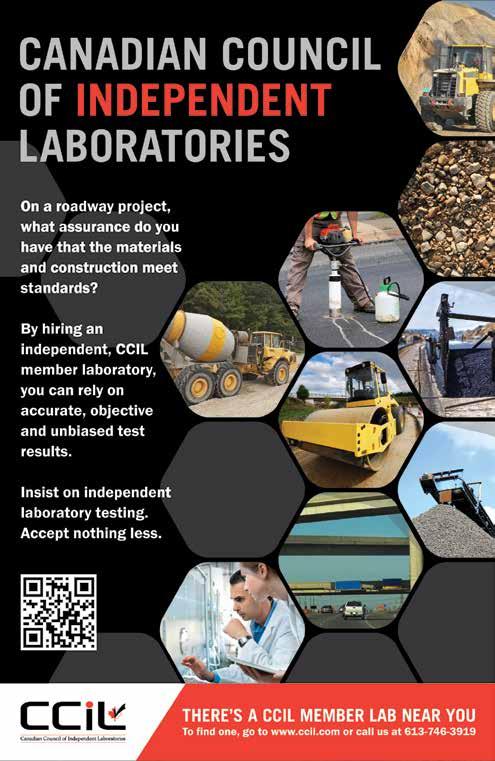
SPRING 2024 13
GLOBAL TRENDS IN ASPHALT & PAVING TECHNOLOGY
What’s the rest of the world doing?


14 OAPC | ASPHALTOPICS
 by Mate Jurkin
by Mate Jurkin
As an industry, it’s important that we stay informed about global trends in asphalt and paving technology, and what the rest of the world is doing. This is the first of what we hope will be other articles within ASPHALTopics highlighting advances within the asphalt industry abroad. The focus of this article will be on the asphalt sustainability trends currently happening within the United States.
ENVIRONMENTAL PRODUCT DECLARATIONS (EPDS)
The CTAA Conference that took place in November 2023 in Charlottetown, PEI introduced the concept of EPDs in Canada through a presentation entitled Development of Environmental Product Declarations (EPDs) for Pavement Materials in Canada by Alan Carter and Annie Levasseur from Ecole de technologie superieure in Montreal, Jean-Martin Crouteau of Colas Canada Inc., and Vincent Grosshenny of Colas SA.
During the 97th Annual ORBA Conference that took place in Toronto in February 2024, Joseph Shacat, Director, Sustainable Pavements of the National Asphalt Pavement Association (NAPA), presented on Reducing the Asphalt Industry’s Carbon Impact: Overview on LCAs and EPDs. Shacat explained what EPDs are and why they have become important to the asphalt industry south of the border. NAPA has developed a third-party-certified Environmental Product Declarations software for HMA called the Emerald Eco-Label EPD Program . The EPD is similar to a consumer food nutrition label. There are key standard parameters of importance to the consumer. An example parameter is the GWP (Global Warming Potential) for asphalt that would have the same importance as carbohydrates in food. The lower the product GWP or carbon footprint, the better, while still providing the necessary performance benefits.
The EPD is an important tool in educating road owners, property managers and specifiers what the carbon footprint of a tonne of asphalt is based on contract mix design specification requirements. NAPA is currently completing the second round of data collection for the EPD Industry Average Benchmarking Initiative. The objective of this study is to support the Environmental Protection Agency (EPA), the Federal Highway Administration (FHWA) and state highway associations (SHAs) on what is the average carbon footprint for a ‘standard’ mixture in each state based on at least three independent asphalt producers. This information can then be used for any future specification requirements on the carbon footprint for a ton of asphalt.
SPRING 2024 15
››
(Miller)
As an industry, as we collaboratively work towards carbon neutrality, this is a start to being able to measure carbon cradle-to-gate which equates to the amount of carbon that is required to produce a tonne of asphalt before it leaves the gate of the asphalt plant. As we progress, the concept will
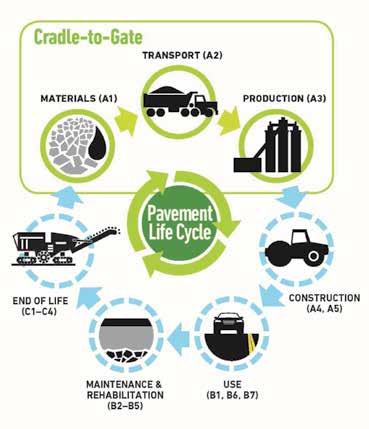
An example of the environmental impact indicators reported in an EPD for asphalt mixture.
evolve to cradle-to-grave which will consider the life cycle carbon impact of roadways allowing for comparison between different pavement designs, products, and materials such as concrete. The EPDs will not only highlight the carbon reduction potential for increasing RAP without diminishing quality, but will also consider the distance from the quarries, the type of fuels used within the HMA production facilities, and overall energy efficiency of each facility.
Here in Ontario, as more U.S.-based companies bring their business north of the border, many of them require LEED certifications and/or EPDs as a criterion for the construction of their facilities which only makes it more paramount for them to be adopted here in Ontario sooner than later.

EPA ENERGY STAR CHALLENGE FOR INDUSTRY
NAPA has partnered with the EPA Energy Star program to offer to its members the opportunity to participate in the EPA Energy

Star program. By joining the program, a NAPA member has access to energy experts who will provide insight into what actions and initiatives can be implemented to lower the energy consumption at an HMA plant. The program establishes an energy benchmark with a target to reduce energy by 10 per cent over five years. When the facility achieves the 10 per cent reduction, it is then certified EPA Energy Star.
Here in Ontario, Enbridge has an established energy reduction incentive program to help motivate all industries to reduce their carbon footprints. The monetary benefit from the incentive is only a fraction of the true savings of each of these projects, but the limitation to the program is that it is project based. The revamped Asphalt Plant Trillium Certification will be a great platform to incorporate such a standard into the HMA plants here in Ontario.
BALANCED MIX DESIGN
The Balanced Mix Design (BMD) approach is a shift from the conventional specification-based designs to one that incorporates performance-based attributes with tests such as, but not limited to, the Hamburg Wheel Track Test, Illinois Flexibility Index (I-FIT), Disk-Shaped Compact Tension (DCT) Geometry, Interlayer Shear Strength (ISS), etc.
Concerns with durability and cracking issues of asphalt pavements, along with the growing awareness of the shortcomings of volumetric mix design systems, have driven many state highway agencies (SHAs) and the asphalt pavement industry to explore the use of BMD as a new approach to asphalt mix design and production acceptance. Balanced Mix Design allows for the optimization of mixes in terms of costeffective material use (e.g., asphalt binder, aggregate, recycled material, additive, etc.) and performance. Without knowing the true performance of mixes, decisions on material use will likely be made based on assumptions, experience (which may not hold true currently), raw cost alone or current specification limits and constraints.
A total picture concept of materials plus performance provides the most benefit in terms of managing risk and increasing margin opportunity. Ultimately, BMD should lead to longer
16 OAPC | ASPHALTOPICS
Photo NAPA
lasting asphalt pavements with fewer maintenance actions resulting in a more sustainable pavement with lower overall life cycle analysis and costs. Many SHAs are collecting laboratory performance test data on current mix designs and several SHAs have implemented the use of BMD with monitoring programs to assess actual field performance.
A region here in Ontario has incorporated these performance tests within their acceptance criteria for some of their road projects for the 2024 season which is a huge step in the right direction. Outside of North America, European countries and their respective cities have been using BMDs for many years with great success. One fundamental key to the success of these approaches as seen in Europe is that there is trust between agencies and contractors where the contractors are able to develop their own products to meet the required performance specifications with the caveat that they warranty the performance of their roads for 7+ years compared to the one to three years we have here in Ontario.
FEDERAL FUNDING FOR LOWER CARBON PRODUCTS
The U.S. General Services Administration (GSA) federal agency has $2.15 billion available through the Infrastructure Reduction Act to procure lower embodied carbon materials
for construction and renovation projects. This is a first and it allows construction materials suppliers to offer to the agency substantially lower levels of embodied greenhouse gas emissions associated with their raw materials, transportation, and manufacturing. The construction materials targeted are asphalt, concrete, steel and glass for use in the building and infrastructure at the GSA property. Eleven projects have been awarded throughout the United States and more projects are being prepared for tender.
This is full circle as the federal funding is directly tied to carbon reduction projects where all the tools outlined in this article (EPDs, EPA Energy Star Challenge and BMD) help support the initiative at the HMA producer level.
The sustainability trends in the U.S. are gaining momentum and represent a major paradigm shift in asphalt technology. It is expected that this trend will greatly influence our own approach to asphalt technology in the near future.
Mate Jurkin, P. Eng., is GTA Asphalt Plants Manager for The Miller Group. Special thanks to OAPC past president, Paul Lum of Colas Inc. in the USA, and Jean-Martin Croteau of Colas Canada, for their input into this article.

SPRING 2024 17
Trillium Award strong in 2023
by Lara Henry
Trillium award winners care about:
· quality
· the environment
· their neighbours


“It’s been another successful year for the Trillium Award program,” says Mike Deckert, Vice President of FLO Components Ltd. and chair of the OAPC Plant and Paving Committee. “We awarded nine plants with the Trillium Award and renewed the award for an incredible twenty-two plants! With all the changes happening in our industry, it’s clear that our members see the value of the Trillium Award.”
The Trillium Award has been recognizing plants that go above the already gold standard set by industry regulations since 2002. In 2016, the Plant and Paving Committee initiated a campaign to have 100 per cent of OAPC plants meeting the standards of the Trillium Award. To date, 111 plants have earned the Trillium Award and 169 award renewals have been issued.
Recipients of the award have to complete a rigorous selfassessment process to meet high standards in appearance, operations, environmental, safety and community relations. Plants that receive the Trillium Award retain the status for three years and are then eligible for award renewal.
John Thomas, General Manager of K.J. Beamish Construction Co. Inc., was involved in certifying two plants for the company, both for the first time. He had previously been involved in the certification of an asphalt plant for the company in 2017. “We want employees to take pride in where they work and take personal ownership in their environment. The Trillium Award aligns well with that and the application criteria cover all aspects of running a quality plant.”
Where are we today?
• 152 plants in Ontario (approx.)
• Roughly 95% are OAPC/ORBA members
• 111 new Trillium Awards issued
• 169 Trillium renewals issued

In terms of the plant’s first experience going through the certification process, Thomas says they found the experience quite straightforward. “We went through the process methodically and didn’t find it onerous at all,” says Thomas. “Going through the process also allowed us to better capture what the knowledgeable people in the plant know so that knowledge can be easily passed on to others. It’s easier if someone new comes in because everything is documented.” ››

SPRING 2024 19
THE NINE NEW 2023 TRILLIUM AWARD WINNING PLANTS ARE:

FOWLER CONSTRUCTION COMPANY LTD.
Rosewarne Asphalt Plant
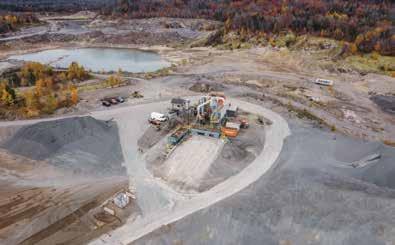
ELLWOOD ROBINSON INC.
Ellwood Robinson Asphalt Plant

FOWLER CONSTRUCTION COMPANY LTD. Madill Asphalt Plant

BEAMISH CONSTRUCTION INC.
Spragge Asphalt Plant
The 2023 Trillium Award renewals effective through 2026 are:

D. CRUPI & SONS LTD.
Oshawa Asphalt Plant

D. CRUPI & SONS LTD.
Passmore Asphalt Plant

D. CRUPI & SONS LTD. Bethridge Asphalt Plant

D. CRUPI & SONS LTD.
Brimley Asphalt Plant

BRANTCO ASPHALT AND MATERIALS LTD.
Cambridge Asphalt Plant

THOMAS CAVANAGH CONSTRUCTION LTD. 77009 Asphalt Plant


STEED AND EVANS LIMITED Kitchener Asphalt Plant
THE MILLER GROUP Georgian Asphalt Plant #29

THE MILLER GROUP Mosport Asphalt Plant #25

THE MILLER GROUP North Bay Asphalt Plant #13


THE MILLER GROUP Pave-Al Asphalt Plant #26
20 OAPC | ASPHALTOPICS
THE MILLER GROUP Tapscott Asphalt Plant #28

PIONEER CONSTRUCTION INC.
North Bay Asphalt Plant

GREEN INFRASTRUCTURE PARTNERS (GIP) INC.
Leaside Asphalt Plant


THE MILLER GROUP Timmins Asphalt Plant #17

GREEN INFRASTRUCTURE PARTNERS (GIP) INC.
Belleville Asphalt Plant

GREEN INFRASTRUCTURE PARTNERS (GIP) INC.
Boyce Asphalt Plant

GREEN INFRASTRUCTURE PARTNERS (GIP) INC.
Kemptville Asphalt Plant

GREEN INFRASTRUCTURE PARTNERS (GIP) INC.
Bearbrook Asphalt Plant
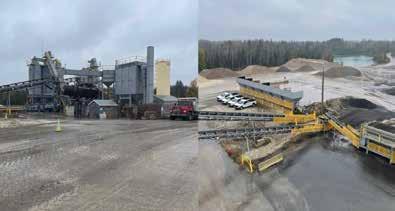
GREEN INFRASTRUCTURE PARTNERS (GIP) INC.
Orangeville Asphalt Plant
Our goal is for all OAPC member plants in Ontario to achieve the Trillium Award. Don’t delay and start on your application today. Find the application package on the OAPC website under Awards/ Trillium Award.

GREEN INFRASTRUCTURE PARTNERS (GIP) INC.
Kitchener Asphalt Plant

GREEN INFRASTRUCTURE PARTNERS (GIP) INC.
London Asphalt Plant

GREEN INFRASTRUCTURE PARTNERS (GIP) INC.
Maple Asphalt Plant

GREEN INFRASTRUCTURE PARTNERS (GIP) INC.
Nebo Asphalt Plant


GREEN INFRASTRUCTURE PARTNERS (GIP) INC.
Oshawa Asphalt Plant
GREEN INFRASTRUCTURE PARTNERS (GIP) INC.
Wilson Asphalt Plant
VIOLA ASPHALT INC. Markham Asphalt Plant
›› SPRING 2024 21
Winners meet high standards in:
· Appearance
· Environmental
· Permitting and
For those considering the Trillium Award for the first time, he recommends starting the process early. “We started talking about the award once the plants opened and had our first meetings in June. By July we had set our goals and started the process, and then had further discussions as we moved closer to the deadline. By starting early we had time for everyone to share their ideas and we could make any changes without being pressured – and complete the process around the day-to-day of running the plants.”
“We found having team meetings very helpful,” he continues. “We went through the application form with everyone first, identifying what was already in place and what had to be done. Once everyone saw that many of the requirements were already completed, it didn’t feel as daunting.” Thomas also says that to get the most out of the process, plants should strive for more than just meeting the minimum standards, but go for the highest possible scores.
Drone technology now makes the photographs and videos required for the application process much easier. It’s also a good idea to choose a season and time to do the photos and video so that they can show the plant in production. The OAPC website includes tips for shooting the videos for the application package under Awards/ Trillium Awards
“We took the photos and cell phone video first which is so much easier now with drone technology. Then we used the images to look at everything and see where any improvements could be made. Starting with the images gave us the opportunity to see with fresh eyes. We also showed those images to someone who wasn’t involved with the plant to see if they had any additional ideas,” says Thomas. “We were impressed when the videos were finalized to see how much

·
Operations
· Safety
·
22 OAPC | ASPHALTOPICS
· Community Relations Compliance
Industry Participation
better we were than when we started, and everyone has been so proud to showcase the work environment we experience every day.”
Trillium-awarded plants receive plaques for their facilities and can order silo decals to showcase the award. “We would like to see a silo decal on every plant in Ontario,” says Deckert. Decals can be ordered through the OAPC website under Awards/Trillium Awards .
“We’ll be ordering decals for our plants and advertising ourselves as a Trillium-awarded plant,” says Thomas. “Everyone at the plant took ownership and got involved in the process. They feel a great deal of personal pride in this achievement and are very proud of their accomplishment.”
Updates to the Trillium Award for 2024 include the 6th edition of the Environmental Practices Guide (EPG) released by the Environment Committee which will be reflected in the environment section of the application.
During the past year, discussions have also been underway to determine the future of the Trillium Award program and moving the current selfassessment process toward a thirdparty inspection certification program.
A Trillium Ad Hoc Committee comprising of industry stakeholders and municipal partners was formed to develop recommendations on the future of the Trillium Award. OAPC sent out two surveys about the future of the Trillium Award program – one to municipalities in partnership with Good Roads, and one to OAPC members. The outcome of the surveys was presented to members of the Ad Hoc Committee and Plant and Paving Committee, as well as included in a presentation at the Good Roads conference in April 2023.
A Request for Proposal for the development of a framework for a Trillium asphalt plant certification program was released in November 2023 with a closing date of February 16, 2024. Proposals are being reviewed by OAPC and a decision will be made on how to move forward.
Lara Henry is a communication specialist and editor of ASPHALTopics.

SPRING 2024 23

Kneading
action of dynamic material flow delivers increased density behind the screed
The first independent floating screed design for asphalt paving hit the market more than 90 years ago. The industry saw the first hydraulic asphalt paver introduced 65 years ago, and asphalt contractors first began paving with variable-width screeds in 1980. The one constant concept throughout all those firsts – a flat screed plate.
24 OAPC | ASPHALTOPICS
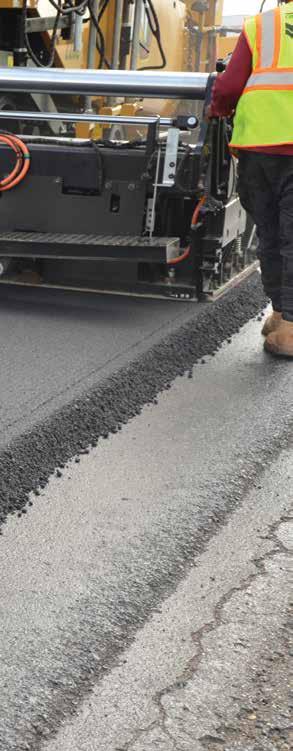
 by Jon Anderson
by Jon Anderson
For 90 years, conventional wisdom and accepted practice has been that to get a smooth, dense mat, a flat surface screed plate is required. Still today, most screeds used in North America employ the combination of high vibration frequency and a flat screed plate positioned at a predetermined angle of attack to achieve densities reaching 80 per cent or higher behind the screed.
Yet this does not serve to optimize mat density, leaving the rollers in the paving train to substantially increase densities to meet spec. The tamper bar screed design is often used in many countries to increase density behind the paver. However, for North American asphalt contractors who expect paving speeds of 30-, 40- or even 50-plus feet per minute (~10 to 15 m/min), the tamper bar screed simply limits productivity too much.
Last year, Caterpillar Paving introduced a first-in-the-industry screed plate system that broke away from the 90-year flat screed plate tradition. Originally developed by a U.S. paving contractor for its paving operation, the design incorporates an angular, not smooth, surface bottom that provides a kneading action to the asphalt material as it passes through the grooves.
Throughout testing, densities reaching and, in some cases, exceeding 91 per cent behind the screed have been achieved. Additionally, improvements in International Roughness Index (IRI) scores were observed, as were more uniform mat temperatures.
NEW SCREED PLATE SYSTEM
“The new Cat SDX Screed Plate System offers two innovative departures from traditional screeds,” explains Nate Just, Marketing Manager for Caterpillar Paving. “The first is a three-dimensional (3D), angular plate design that improves density behind the paver. The second addresses shortcomings in how the modular screed plates are mounted, which significantly reduces the amount of time it takes to replace screed plates.”
The added third dimension at the front of the screed plate tapers to a flat surface toward the rear to provide a smooth finished mat surface. The angular grooves channel and manipulate the mix as it passes from front to rear, enhancing the structural integrity of the asphalt. The confined kinetic mixing action also helps to increase the bond interface between the asphalt binder and aggregate to create a more uniform surface texture.
In the field, this improved mat integrity has been shown to lessen compactor shoving of material, strengthen the unconfined edges and promote better surface temperature uniformity, which provides more consistent compaction across the mat’s width. With the optimized aggregate structure minimizing roller shoving, this helps to increase mat smoothness and improve joint matching at the strengthened unconfined edges. ››
››
SPRING 2024 25
(Caterpillar)
The higher densities left behind the SDX screed have a positive impact on the paving train as fewer roller compaction passes may be required and, in some cases, an asphalt compactor has been eliminated from the rolling strategy. Densities reaching 91 per cent and higher behind the paver are being reported by contractors in the field along with higher densities at the longitudinal joint due to less lateral movement of the mix under the drums. Contractors have also benefitted from roughness reductions with the IRI scale. All these factors are helping contractors to realize more bonus opportunities.
While traditional screed plates are run with an elevated front angle of attack, which increases plate wear, the grooved front section of the SDX plates performs a similar function as the angle of attack, so they run flat and wear more uniformly to reduce cost. Additionally, the 3D plates are cast and made of high strength chromium carbide for high wear resistance and longer life in the field.
FASTENING SYSTEM INNOVATION
Changing or replacing worn screed plates is another drawback to conventional screed designs. Paving contractors make their best efforts to get a season out of the screed plate so they can be changed during the off season when paver service is scheduled. Otherwise, changing conventional screed plates can take the paver off the job for at least a day, possibly two.
The SDX screed plate system’s second innovation reduces plate change time enabling a contractor to change the screed plates in as little as four hours. This gives the contractor more flexibility in scheduling time for replacement, minimizing paver downtime for the contractor. Contactors have also seen that the cast SDX plates made with high strength chromium carbide deliver longer plate life than traditional screed plates.
After a one-time installation of the insulated conductor plate, screed plate changes are simplified using a unique lock-andgo system. This eliminates the time-consuming process of removing asphalt residue from the screed to access the nuts and bolts holding the plates in place. Heating elements attach to the aluminum adapter plates. They serve to provide efficient and uniform heat distribution across the width of the screed to help reduce the occurrence of thermal segregation and asphalt material sticking to the screed.
The beveled edges of the adapter plate function as a tool carrier to accept the SDX screed plates. “The modular design incorporates 12 inch (300 mm) plate sections interchangeable across the screed’s width to maximize wear life,” explains Just. “At the screed centre, six 4 inch (100 mm) sections allow for crowning to be adjusted at the center of the screed.” These hardware-free screed plates are held in place using a patented tool-free locking system.
POSITIVE FIELD RESULTS
In 2023, Caterpillar followed several paving contractors representing various regions throughout the United States. The studies compared conventional screed plates against the SDX system to analyze smoothness, density, temperature uniformity, air void content and other paving parameters when paving with a variety of mix designs.
One contractor from the eastern United States paved with the same mix on the same application with both the SDX and traditional plates. Using identical rolling patterns, cores showed approximately 1.5 per cent better final density
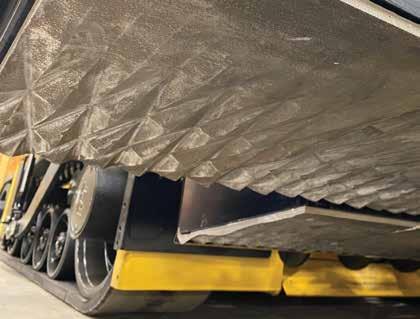
using t he SDX plates plus increased density at the joints. Mix roll-down was lowered from 0.25 inches (6.35 mm) to 0.125 inches (3.8 mm) when using the SDX system since these plates knead the material tighter directly under the screed. The contractor changed the rolling pattern from 3 vibratory/4 static passes to 2 vibratory/5 static passes, resulting in IRI readings roughly 10 to 15 inches/lane mile (155 to 233 mm/km) better with the SDX and a bonus payout.
In the southern United States, the contractor on a road widening and rebuilding project paved 5 inches (127 mm) of a 1 inch (25.4 mm) base mix compacted to 4.125 in (~105 mm). With a target density of 95 per cent on the project, the paver equipped with conventional screed plates achieved 89 to 90 per cent density behind the screed, whereas the SDX plates delivered 91 to 92 per cent density. Each vibratory pass with the roller increased density by one per cent, while two passes with the pneumatic
26 OAPC | ASPHALTOPICS
The angular plate design of the SDX screed kneads the surface of the mat. (Caterpillar)
roller provided another one per cent density increase. The contractor’s quality control person speculated that they could eliminate the pneumatic roller from the paving train and make just three passes with the double drum roller behind the SDX screed plates. Additionally, the thermal camera showed uniform and consistent temperatures across the width of the screed.
A project in the Midwest called for a 2.375 inch (60.33 mm) surface lift paved 14 ft (4.3 m) wide at 30 to 35 ft/min (9.1 to 10.7 m/min). The PG 58-34 mix design included 47 per cent RAP and paving temperatures ranged from 280˚ to 306˚F (138˚ to 152˚C). With 100 per cent bonus pay earned at 92 per cent compaction, density readings behind the screed with the SDX plates measured 92.3 per cent, and compaction consisted

temperatures between 295˚ to 305˚F (146˚ to 152˚C). The contractor paved at 40 ft/min (12 m/min) at 16 ft (4.9 m) wide with a lift thickness of 1.625 inches (41.28 mm).
The original five-pass rolling pattern was reduced to three passes to meet spec density of 93 to 94 per cent. The superintendent commented that normal density behind a standard screed averages 81 per cent, while the SDX screed delivered 86.4 per cent density behind the screed. The SDX screed delivered roughly five per cent better screed density and one to 1.5 per cent overall density increase after compaction.
Jon Anderson is Sales Support Consultant for Caterpillar Paving.
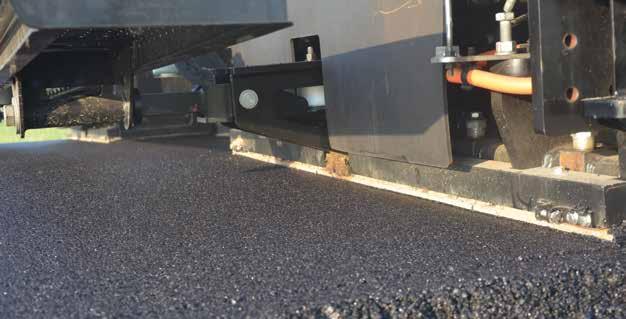
of only one static and two vibratory passes. The measured density was 93.8 per cent after a single breakdown pass, and the project earned 100 per cent of the available density bonus.
IRI measurements and air voids were the focus of a second study comparing Cat SDX plates against standard plates in southern United States. The section paved with the SDX plates generated roughly a 24.6 per cent better IRI measurement than the standard plate, posting 24.4 inches/ mile (385 mm/km). Additionally, there was a 0.6 per cent air void difference between the two screeds, with the SDX showing better density and less air voids while using the same rolling pattern.
A final comparison study from the Midwest covered a PG 58-28 mix design with 6.5 per cent AC and 18.4 per cent fractionated reclaimed asphalt pavement (FRAP) paved at
* Note: The
Caterpillar’s field studies have shown the SDX Screed Plate System does what it’s designed to do. Its kneading action caused by the 3D screed plate bottoms helps to improve density and leads to improved air void content in the compacted mix. Additionally, contractors have reported better mat texture, a smoother mat and lower IRI numbers when paving with the SDX screed plates.
Close view of the surface of the mat after paving with the SDX screed. (Caterpillar)
SPRING 2024 27
information provided was gathered from customer experiences when utilizing the Cat SDX Screed Plates. Results may vary due to paving practices, job site conditions, and the asphalt mix designs being utilized.
by James Careless

Regan Cox doesn’t just bleed black – he lives for asphalt!
The OAPC Bleeds Black Award is the Ontario asphalt industry’s version of the Oscar. To win this prestigious honour, the recipient must be an asphalt industry professional who lives and breathes for this industry and for the betterment of everyone in it. In the words of past OHMPA director Tim Fawcett, they must be someone “whose passion and commitment for all things asphalt is so great that when cut, they bleed black.”
The 2023 winner of the Bleeds Black Award is Regan Cox, president of Cox Construction in Guelph, the company founded by his father, Russel Cox, in 1946. Regan Cox has worked at Cox Construction since 1978.
“I started working at our family firm during high school, and then joined after university,” says Cox. “I have followed in my father’s footsteps, working up through the ranks and becoming president in 2003. Russel is now 98 years young and still comes into work once a week. The only thing I know and care a lot about is asphalt pavement. I do have a working knowledge about concrete, but I have a much keener knowledge of asphalt plants, pavers, asphalt as a material, and as a building material.” Asked why he bleeds black, Cox provides a humorous response. When it comes to asphalt, concrete, and other building materials, “black should be on top,” he explains. “We know it’s the smoothest road service there is going. And after all, asphalt tops concrete on a daily basis.”
“Regan is a colourful individual who looks out for all companies in Ontario, not just his own. He makes sure other stakeholders understand what asphalt is, how the plants operate, and how important asphalt is to Ontario’s economy.” DONN BERNAL
Cox’s colleagues are more effusive in their assessments. “Regan Cox bleeds black because asphalt is in his blood,” says Bruce Armstrong, Director of Sales with Canadian Asphalt Industries. “He inherited this dedication from his father Russel. Regan’s passion for this industry is evident through his love of all hot mix and pavingrelated equipment, his tenure as an ORBA board member and past president, and his participation in the OAPC Environment Committee and the BaP Task Force.”
“Regan has been in the industry for over 45 years through his family business and has been a proud member of various committees and task groups with ORBA and OHMPA/OAPC over the years,” says Donn Bernal, principal of Corfinium Solutions, who nominated Cox for this award. “I would consider him one of our anchors in the industry.”
What impresses Mike Deckert, Vice President of FLO Components, is Regan Cox’s devotion not just to his family firm, but to people in the asphalt industry in general.
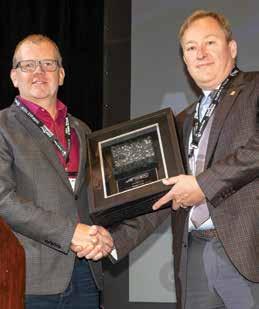
“Being on several committees with Regan, attending association meetings like the President’s Tour and the Fall Asphalt Seminar, and most recently the Asphalt Plant Certification Ad Hoc Committee, I have seen firsthand his commitment and passion to his family, employees, and the industry,” Deckert says. “He is not one to shy away from asking the tough questions, supporting new initiatives or learning, or adopting new technologies. These are all examples of Regan Cox’s commitment to the continual improvement of the asphalt paving industry.” A lot has changed in the industry since Regan Cox joined Cox Construction. “The asphalt plants have gone from levers and clam buckets to electric technology that became relay logic, and now it’s all with PLCs, so the process of making asphalt has become highly automated,” Cox says. “It was actually a vigorous and physical thing to do when you were manually pulling a hand lever that controlled the batching of sand and stone
28 OAPC | ASPHALTOPICS
L-R: Peter Hamstra and Regan Cox

and asphalt into a pug mill. Today, you make a number of clicks with a mouse, push a couple of buttons on the keyboard, hit Save, and then all those things now are done electrically by actuators — no heavy lifting required!”


This being said, one thing that hasn’t changed in Regan Cox’s world view is the need for everyone in the asphalt industry to play an active role in advancing the progress and best interests of the companies and workers who make a good living from this business. This is why Cox has played so many roles in supporting OHMPA, OAPC, and ORBA over the years, and why he remains passionate about industry involvement.
“It’s absolutely imperative that you get involved because if you’re not there at the table, you’re likely going to be on the menu,” he quips. “Seriously, you gain so much more from being involved with ORBA or OAPC’s membership and committees — much more than you would think. Being involved also allows you to be first heard before the message is distributed. And if you have some say on how specs or things of that same nature can be changed, it’s great that you can be heard and provide your knowledge. Besides, it’s rewarding to work with other colleagues with the same ideas.”
When Regan Cox shares his views, they are focused on what is good for all players in the asphalt industry. “When Regan speaks at a committee meeting, everyone quiets down and listens because he usually has something very thoughtful, intriguing, or important to say,” Bernal wrote in support of his nomination of Cox. “And he usually has a perspective that many of us don’t think about, thanks to his years of experience in our industry. Everyone knows of his passion for the industry and making sure we look at all options when creating new initiatives for the association or council.”
Forty-six years on, Regan Cox remains passionate about his work. “When your family name is on every asset you own, it matters,” he says. “So we try very hard to do our best. It does give me great pride to

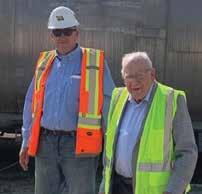
be as successful as we have managed to be in the community, in business, and with the associations I’ve had and have the privilege to belong to.”
James Careless is an Ottawa-based freelance writer with credits in the National Post, Toronto Star, and AI’s Asphalt magazine.

SPRING 2024 29
Key poll results on attracting talent to the industryasphalt
At the Fall Asphalt Seminar on November 30, 2023, OAPC conducted a poll regarding attracting, hiring and keeping new talent to the asphalt industry. Approximately 170 seminar attendees responded to the poll with key results summarized here.
1. Why do you think our industry is struggling to attract and retain young workers today?
2. In your opinion, priority hiring considerations in the asphalt industry should be focused on:
3. What do you consider to be the education and/or experience level required for an entry level position?

4. Is it possible to reach a management position if you start out on an asphalt crew?

30 OAPC | ASPHALTOPICS
Not exciting or general lack of interest Long hours/hard work Misconception that our industry is comprised of “lower class” workers Wage/Compensation 0% 10% 20% 30% 40% 50% 60% 5% 50% 17% 28%
Labourers & Operators Electricians, Millwrights & Mechanics Safety/Environmental Coordinators Quality Control & Field Technicians Operations, Administration & HR Business Partners 0% 10% 20% 30% 40% 50% 60% 70% 64% 2% 5% 2% 26%
University (Bachelor) College Highschool 0% 10% 20% 30% 40% 50% 60% 70% 80% 4% 21% 75%
No Yes 0% 20% 40% 60% 80% 100% 9% 91%
5. Why would someone choose to work on a paving crew versus any other aspect of road construction?
8. What do you feel is the most important information to convey to under-represented populations regarding the asphalt industry?

6. What do you believe is the biggest contributing factor in a low number of applications from women in the asphalt industry?
9. Which of the following should be the primary focus in attracting new talents who may be interested in a career in the asphalt industry?
7. In your opinion, will immigration be a major influencing factor/contributor to attracting talent in the road building industry?
10. Over the next decade, what do you predict will be the biggest challenge for companies in the asphalt industry?

SPRING 2024 31
Work-Life-Balance Negative stereotype of the work atmosphere Other fields are more appealing to women Lack of knowledge of the industry 0% 5% 10% 15% 20% 25% 30% 35% 40% 45% 50% 18% 45% 36% 1%
Workers in other industries College students University students High school students 0% 10% 20% 30% 40% 50% 60% 70% 80% 7% 23% 3% 3%
No Yes 0% 20% 40% 60% 80% 100% 9% 91%
Appreciation of seasonal work Opportunity for better compensation resulting from more work hours 0% 10% 20% 30% 40% 50% 60% 70% 80% 25% 75%
Shortage of work Attracting and retaining talent Adoption of new technologies 0% 10% 20% 30% 40% 50% 60% 70% 80% 90% 4% 11% 85%
0% 5% 10% 15% 20% 25% 30% 35% 40% 45% It is always a challenge and never boring 14% There are a variety of roles you can learn throughout your career 39% The work
rewarding
what your team has
20% The pay can be really good 27%
is very
as you can see
created
DUFFERIN CONSTRUCTION WINS AWARD FOR HIGHWAY 7 PROJECT
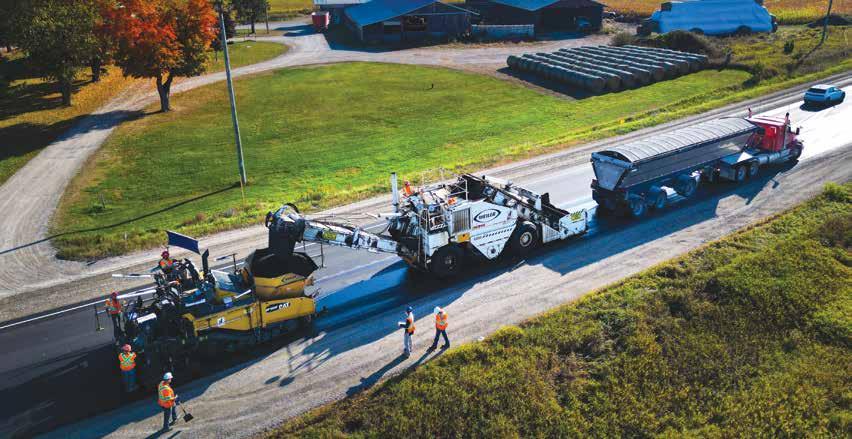 by Steve Pecar
by Steve Pecar
For the second year in a row, Ontario’s Ministry of Transportation (MTO) has named Dufferin Construction (a division of CRH Canada Group Inc.) as asphalt Paver of the Year for work done along a stretch of Highway 7.
The presentation of the 2023 award was made by Doug Jones, Ontario’s Deputy Minister of Transportation, during the Ontario Road Builders’ Association 97th annual convention held in Toronto from February 4 to 6.
“This is very welcome news,” says Ehsan Fard, District Manager for Dufferin Construction. “We all knew we had something special with this project and everything worked out right. There was a lot of hard work put into this job and it shows in the results.”
Paver of the Year is presented annually by MTO to recognize contractors who have completed high-quality asphalt projects for the government. In making its selection, MTO judges a project outcome on several conditions including smoothness of the road surface, completion, new technology/ methodology, workmanship, mix quality and visual appearance.
Dufferin was chosen for contract 20234011, Highway 7 from 0.4 km east of Slanted Road to the west limit of the hamlet of Omemee in the City of Kawartha Lakes.
Other finalists were:
• J&P Leveque Bros., contract 2022-5020, Highway 118 from 0.3 km
east of Highway 35 easterly to 0.7 km west of Haliburton Road in Haliburton;
• Pioneer Construction, contract 20226017, Highway 599 from 5.2 km north of the Kenora/Thunder Bay District boundary northerly for 27.3 km to Savant Lake CNR crossing in Savant Lake; and
• Thomas Cavanagh Construction Ltd., contract 2023-4008, Highway 401 from 0.8 km west of Carman Rd. to 0.7 east of Upper Canada Rd. near Morrisburg.
According to Fard, Dufferin’s 11 km project started in July of last year and wrapped up by the end of October. The work included pulverizing, grading, curb construction, some culvert and sewer installation, and the placing of 32,000 tonnes of both warm and hot mix asphalt. The project called for a reconstruction of the highway along with some road widening.
“It was a good job for us,” Fard explains. “There are a lot of unknown conditions when dealing with older roads as was the case here, but we have a very experienced team that works on projects in that part of the province and they are very good at finding solutions.”
Fard says that very early in the project, the desired results were being achieved. When the binder lift was placed, it
was quickly noticed how smooth the surface was because of the excellent workmanship of the paving crew.
“We had to tell them ‘No, we still have to go back and do the top,’” he says. “When that happens, it is something special and we are very pleased. Everything went so well. The material was placed on time; there was no waiting. The team made the right decisions to ensure continuous paving which impacts on the quality of the asphalt.”
Fard says MTO officials who visited the site were impressed with what they found and helpful when challenges were encountered that required their input. He says their encouragement was appreciated.
“It gives you that extra burst of energy when you get positive feedback before the job is even done. We take pride in our work and when we know the customer is happy, and they reward you for your work, it makes the job even more satisfying.”
Fard says the project is now one that Dufferin can look back on with pride and shows the company is up to the everevolving challenges of the industry.
“Dufferin has been around for more than 110 years,” he says. “There are challenges to be met every day, but it is our job to meet those challenges by providing solutions for our customers — it’s part of our DNA. We’re ready to go another 100 years, and hopefully, next year we will achieve three in a row for Paver of the Year.”
32 OAPC | ASPHALTOPICS
by Steve Pecar
Taking care of business comes naturally for Donato Rita

here is a familiar theme that arises when colleagues in the asphalt paving industry talk about Donato Rita. “He takes care of business,” says Mike Deckert, Vice President of FLO Components. “He knows what to do and he does it well.”
According to Deckert, who has served with Rita on OAPC (and previously OHMPA) committees, Rita has a lot of handson experience and is quick to share what he knows and has learned. “He is always there to support OAPC and provides very good insight into whatever we are talking about,” Deckert continues. “He has the ability to cut through some complex issues and explain them so that everyone can understand.” Rita appreciates the accolades and says the insight he now shares comes from the years he has spent learning from others, those whose footsteps he has followed and the mentors who were willing to pass down their on-the-job earned experience.
“I’ve worked with and learned from a lot of great people in this industry,” Rita says. “They showed me the ropes and how it was done, and I took in everything they had to teach me. Now I try to do the same even though I’m still learning myself.”
It started with Rita taking on jobs each summer with his uncle’s excavation business. He says he enjoyed the work right from the start realizing that the intricacies of each project kept him interested and eager to keep coming back.
His passion for the profession led him to pursue civil engineering in school and his combined experience landed him his first job in 1996 at Warren Paving and Materials. Rita has been with the company ever since, even though it has changed hands several times and is now known as Green Infrastructure Partners (GIP).
As a supervisor, Rita oversees major projects, putting him right in the thick of things which is just the way he likes it.
He credits the team he works with for making the job come together each day, saying he has been lucky to have had such accomplished crews over the years.
“I love being busy and look forward to the work in front of us each day, especially when I am surrounded by a great team,” Rita says. “Every job is different, every person you deal with has a different perspective, and I like that.”
Rick Logozzo, Regional Vice President at GIP, has worked with Rita since they met at Warren and believes his colleague is one of the best in the business at what he does. “Donato is a seasoned professional with the ability to run construction projects with finesse, showcasing exceptional work habits and reliability,” says Logozzo. “He provides GIP with a blend of organizational excellence and outstanding management of time, budget, and resources while consistently exceeding expectations.”
While he has risen through the ranks of the company, Rita says where he is now is where he wants to remain. He believes he is most effective out on the road, whether it’s doing jobs for MTO, municipalities or private jobs, and doesn’t envision himself in an office or behind a desk.
He points to projects such as the Gardiner Expressway as ones that keep him motivated and get the adrenaline flowing for all involved. “With the weekend Gardiner projects, you just have 48 hours to get it done. They are the most challenging ones but the best,” Rita says. “You have multiple crews doing different types of construction and it has to happen; it has to work. You have to hammer down and just go.”
Rita will take that same approach as he tackles new projects in the weeks and months ahead. “It’s what I love doing — out on the road just doing my job.”
UNSUNG HEROES
Donato Rita
SPRING 2024 33


TECHNICALLY SPEAKING
Doubra C. Ambaiowei Director, Technical Services
Building momentum for a high-RAP pave-in in Ontario
Circling back to my fall 2023 ASPHALTopics Environmental Essentials article “Saving the environment – A collaborative goal with RAP,” there is an opportunity for interested municipal road owners, industry partners, and material suppliers to collaborate on reviewing the challenges and opportunities of designing, producing, and placing high-RAP asphalt mixtures in Ontario.
This focus on high-RAP mixes kicked off at a Good Roads-OAPC Municipal HMA Liaison Committee meeting in late November 2023. Since then, OAPC has presented interested parties with a Pave-in: Technology Demonstration Day proposal to facilitate practical experiences for learning and knowledge transfer, and promote general industry expertise with high-RAP technology. A pave-in demonstration featuring production and placement of a high-RAP mix will drive the factors for use of RAP in asphalt pavements, namely economic savings and environmental benefits. In addition, improvements and confidence can be re-introduced into the practice of recycling that optimize the use of natural resources and sustain the asphalt pavement industry, including more widespread use of higher amounts of RAP in asphalt mixtures.
Consequently, OAPC encourages support from municipal road-owners and the HMA industry, especially rejuvenator manufacturers, to improve on Ontario’s recycling experiences, and guidance to its jurisdictional approach on the use of higher
percentages of RAP mixtures, as well as bridge any perceived gaps in information on performance, best practices, and long-term performance monitoring of recycled pavements in Ontario.
Currently, the experimental methodology and mix matrixes for evaluation are being discussed in hopes for buy-in from potential collaborators and project sponsors. OAPC proposes an evaluation of the impact that RAP in varying percentages will have on a conventional Ontario Superpave 12.5 mm mix typically used for “Category C” traffic or municipal roadway as defined in OPSS 1151.
The experimental plan is expected to demonstrate that it is possible to design, produce and place a surface and intermediate type Superpave mixes incorporating RAP percentages up to 50 per cent without compromising the specified consensus properties and volumetric characteristics, their overall laboratory and in-service performance, as well as evaluate the impact of using rejuvenators in recycled mixes.
An array of possible mix configurations, with due considerations to be given to traffic applications, zonal PGAC selection guidelines, optimal rejuvenator dosage and type to be incorporated in the high RAP mixtures will be investigated. Ideas and recommendations are welcome regarding available rejuvenation agents and design considerations for optimal
››
SPRING 2024 35
FACT SHEETS
RAP
dosage applications. The knowledge gap in rejuvenator use is not only limited to the type used, but also to the optimal dosage, compatibility with virgin and RAP binder, stability under the elevated temperature atmosphere, mix design and manufacturing process, and uncertainties about the long-term performance of the revitalized highRAP mixes.
To properly evaluate the performance of the Superpave asphalt mixtures in the project matrix, a thorough testing, sampling, and monitoring plan will be implemented. The plan will include laboratory performance testing, and pre- and post-testing of the trial demonstration test sections to compare both the laboratory and in-service field performance. A balanced RAP mix design approach has been recommended for this study.
OAPC is proposing a Pave-in: Technology Demonstration Day
to facilitate practical experiences for learning and knowledge transfer, and promote general industry expertise with high-RAP technology.
OAPC recommends that the consideration for balanced mix design should aim toward selecting the final asphalt content after optimizing the mix density, rutting, and cracking requirements. As a reminder, RAP handling in the process of mix design is critical, especially the mixing and compaction temperatures for high-RAP mixes. It is recommended that the mixing and compaction temperatures used for the virgin binder be used for the RAP mix as well.
The construction of field trial sections containing different levels of RAP will further demonstrate and validate the balanced RAP mix design. In addition to the standard sampling requirements and procedures towards completing the respective Superpave mix designs, Council recommends due consideration to include a variety of performance tests on the virgin and recycled mixtures to establish baseline measurements. The tests will be conducted in accordance with the Ministry of Transportation Ontario (MTO) standards.
The proposed high-RAP trials and paved demonstration sections will provide valuable data on the use of RAP in asphalt pavement. A thorough testing and evaluation plan, along with the collaborative support of all involved parties, will ensure that the data obtained is reliable and accurate. The data will help to progress the industry towards the responsible and quality use of recycled materials in asphalt pavement, and ultimately lead to a more sustainable and environmentally responsible infrastructure.
It would be beneficial to explore and leverage available external funding opportunities for this important project, and the National Research Council Canada (NRC) has been identified as part of an upcoming project initiative on the “Use Reclaimed Asphalt Pavement and Recycled Concrete Aggregate in Hot Mix Asphalt and Roads Backfill.” The NRC’s focus aligns with the OAPC’s objective to stimulate the provincial and municipal specifications to optimize the use of RAP and warm-mix asphalt.
In Ontario, RAP content is restricted to around 15 and 30 per cent when it is used in the surface course and binder course, respectively. The former can be increased to
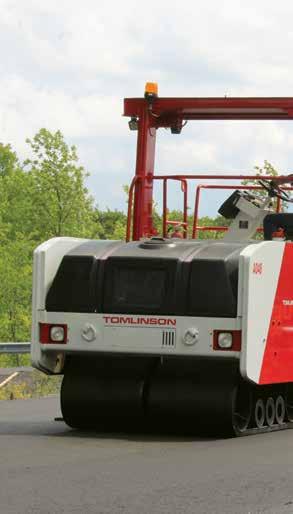
20 per cent contingent on the terms of the contract. An additional approval by the contract administrator is required in mix design if 31 to 50 per cent of RAP is used in the binder course. Nevertheless, RAP content beyond 50 per cent is not allowed in any cases.
The Pave-in: Technology Demonstration Day was originally introduced in 2011 and featured the capabilities of Dynapac’s CM2500 model paver to demonstrate the “hot-on-hot” laydown technique of placing two lifts of asphalt virtually simultaneously. The trial was completed on an eight kilometre stretch of Highway 12 near Midland, with the existing pavement being pulverized and then replaced with a hot-on-hot layer of asphalt. Following its initial success, a second hot-on-hot pave-in was staged in 2012, this time on the full length of a QEW project in Fort Erie, stretching four kilometers.
In 2019, OAPC hosted another pave-in co-facilitated by the MTO, Carleton University’s Centre for Advanced Asphalt Research and Technology
36 OAPC | ASPHALTOPICS
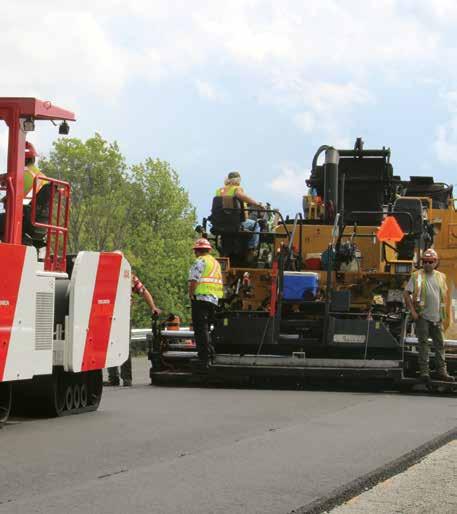
Partnering to advance a high-RAP pave-in experience in Ontario is expected to achieve the following objectives:
• Provide knowledge transfer;
• Stimulate municipal road-owner specifications toward allowance for the use of RAP in surface and intermediate asphalt pavement layers;
• Advance an appreciation of simple and clear criteria for ensuring pavement performance;
• Contribute to enhancing Ontario’s best practices for RAP processing, storage, mixture production, and paving expertise, including minimizing moisture in RAP, fractionation for high RAP use, and stockpile storage;
• Encourage the optimal use of recycling agents such as rejuvenators, binder softeners and/or other additives to facilitate high-RAP amounts in asphalt mixtures; and
• Advance practicality and confidence in the performance of highRAP mixes.
If you would like to learn more or are interested in joining forces towards realizing the objectives of this high-RAP pave-in project, please connect with me at Doubra.Ambaiowei@orba.org. Thank you.


34 AGGRESSOR www.aggressorautomation.com 13 CCIL www.ccil.com 43 CANADIAN ASPHALT www.canadianasphalt.ca 04 ENGTEC www.engtec.ca 17 FLO COMPONENTS www.flocomponents.com 08 GENCOR INDUSTRIES www.gencor.com 03 GIP www.gipi.com 29 GIP www.gipi.com 44 LIEBHERR www.liebherr.ca 06 LIUNA www.liunaopdc.ca 19 M&L TESTING www.mltest.com 22 NHES www.NHES.ca 39 TROXLER CANADA www.troxler.ca 12 UPPER CANADA ROAD SERVICES Inc. www.uppercanadaasphalt.com 02 WIRTGEN www.wirtgen-group.com 23 YELLOWLINE www.yellowline.ca
(CAART), and R.W Tomlinson Ltd. We explored the capabilities of the Asphalt Multi-Integrated Roller AMIR TRAK asphalt compactor, and a permeability testing demonstration.
SPRING 2024 37
AMIR TRAK asphalt compactor from 2019 pave-in. (Nathan Medcalf)

ENVIRONMENTAL ESSENTIALS
Steve Manolis Executive Vice President, GIP Materials Engineering
Environmental Product Declarations (EPDs) for asphalt mixtures
Environmental Product Declarations (EPD) are becoming popular in the U.S. and may be coming to Ontario soon. But what are they, how are they developed and why should we embrace them? OAPC is working on providing answers to these questions to benefit members.
An Environmental Product Declaration (EPD) reports environmental impacts for a product in a concise and standardized format. EPDs are third-party verified and have been described as an environmental nutrition label. They refer to various aspects of the product’s effect on the environment. For asphalt mixtures, the following categories have been adopted by the National Asphalt Pavement Association (NAPA): Global Warming Potential; Ozone Depletion Potential; Acidification Potential; Eutrophication Potential; and Photochemical Ozone Creation Potential.
An EPD is a summary of the output from a Life Cycle Assessment (LCA) where an analysis is performed to determine the environmental impacts of a product or service. This requires a Life Cycle Inventory (LCI) which is the data that has been quantified to determine the material and energy inputs, and the emissions outputs of the product or service being analyzed.
The typical scope of an EPD for an asphalt mixture is a cradle-to-gate analysis which summarizes quantified
environmental impacts associated with producing the asphalt mixture up to the point that it leaves the ‘gate’ of the asphalt plant. The only elements considered are as follows: manufacturing of raw materials (aggregates and asphalt binder required to produce the asphalt mixture covering quarry/pit operations, extraction and refining of petroleum crude oil, and asphalt cement terminal operations); transportation of materials to the plant (the mode of transport and the distances involved); and, production of the mixture at the plant (includes assessments of how the energy used to heat and power the plant is produced). A cradle-togate EPD does not consider impacts from constructing the asphalt pavement, use, maintenance and rehabilitation, and what happens with the pavement at the end of its life (i.e. recycling, disposal). The following simplified figure is based on output from NAPA’s Emerald Eco-Label EPD Tool.
One of most important aspects of an EPD is an independent and verifiable assessment of the environmental impacts. A Program Operator creates the framework used to develop EPDs and their underlying LCAs following ISO standards. ISO 14025 and 21930 govern EPDs, while ISO 14040 and 14044 define requirements for LCAs. General Program Instructions describe the overall framework for the EPD program.
Product Category Rules (PCR) define the rules, requirements, and guidelines used to develop an EPD for a product
38 OAPC | ASPHALTOPICS
category (i.e. asphalt mixtures). PCR are developed through consultation with a stakeholder group which includes public consultation. An independent expert panel reviews and verifies the PCR and LCA data. The Program Operator verifies that the EPD and the underlying LCA conform to PCR requirements. PCR and associated EPDs are valid for up to five years.
NAPA is an approved Program Operator for asphalt mixtures and has developed a software tool known as the Emerald Eco-Label EPD program (see page 15 of the “Global Trends in Asphalt and Paving Technology” article). NAPA’s EPD software allows users to create verified EPDs (cradle to gate) that are plant-specific and mix-specific.
While the scope of the PCR developed by NAPA covers the USA and Canada, plants in Canada are currently not supported by the Emerald Eco-Label EPD software. The PCR requires the use of public data sets for upstream energy and materials, and such data was not readily available for electricity in Canada.
EPDs for asphalt mixes are comparable if they have similar performance characteristics and perform a similar function (i.e. they are intended to meet the same specification). An EPD for a surface mix should not be compared to that of a base mix.
Pavement materials with different PCRs, such as asphalt and concrete, should not be directly compared at the present time as the underlying assumptions used by different
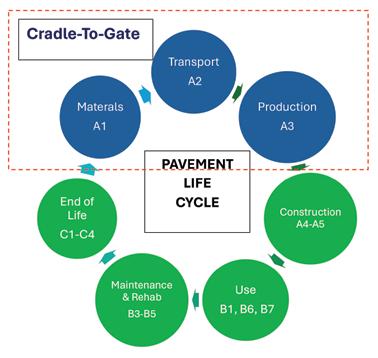
Program Operators during the LCI and PCR development are likely to be incompatible.
EPDs are currently used in Ontario for LEED projects (v4 and 4.1). Credits for EPDs from 20 different products can be collected. Approximately 50 such projects were registered in Ontario in 2022. Canada’s federal Greening Government Initiative has a policy on Green Procurement and a standard on Embodied Carbon in Construction. This standard does not currently apply to asphalt.
The National Research Council’s (NRC) Centre of Excellence in Construction Life Cycle Assessment (CECLCA) provides funding for the Canadian construction sector to develop industry-average LCIs and LCAs of industry manufactured construction products.
OAPC is in discussions with the National Research Council to develop LCA and LCI data sets for asphalt mixtures in Ontario. A stated goal of the project is to expand NAPA’s LCA for Asphalt Mixtures and the NAPA Emerald Eco-Label EPD Tool so that they are applicable to Ontario.

SPRING 2024 39
OAPC 2023 FALL ASPHALT SEMINAR
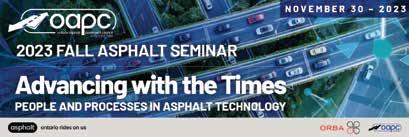
Leading industry experts presented on the evolving landscape of asphalt technology at OAPC’s 2023 Annual Fall Asphalt Seminar on November 30, 2023. The day included a tradeshow and $15 from each registration was donated to the Asphalt Research Fund.
The keynote presentation, Future of Quality Asphalt in Ontario: A Review of Marshall and Superpave Mix Design Systems , was delivered by Dr. Salman Bhutta, Principal, Engtec Consulting Inc.
Other presentations included Energy Transformation and Asphalt Production Trends • Challenges of Attracting and Retaining Talent
• Performance of Asphalt Mixes Modified with Aramid Fibers
• Sustainability and ESG in the Asphalt Industry • Recycling Agents and High RAP Mixes.
THANK YOU TO OUR 2023 SPONSORS:
PLATINUM SPONSORS
OAPC AT MEA
Technical Services Director, Doubra Ambaiowei, discussed the future of the Trillium Award Program at the Municipal Engineers Association’s 2023 MEA conference. The event was co-hosted by the cities of Sarnia and Lambton from November 14 to 17, 2023 in Point Edward with approximately 220+ delegate and vendors attending each day.


Thank you to everyone who attended and to our sponsors. We had an amazing turnout and couldn’t have done it without you. We hope you enjoyed the day and look forward to seeing you at the next seminar!
Click here to view the presentations



 GOLD SPONSORS
SILVER SPONSORS
BRONZE SPONSORS
GOLD SPONSORS
SILVER SPONSORS
BRONZE SPONSORS
40 OAPC | ASPHALTOPICS
Keynote presenter Dr. Salman Bhutta, Engtec Consulting.
THANK YOU FOR YOUR DONATIONS TO THE CP24 CHUM FM CHRISTMAS WISH PROGRAM

For a fifth year in a row, OAPC’s Fall Asphalt Seminar supported the annual CP24 CHUM FM Christmas Wish Program . The program is one of the largest distributors of toys to children in need in the Greater Toronto Area and also provides financial assistance to hundreds of agencies, ensuring that hundreds of thousands of children across the GTA enjoy a holiday experience. OAPC has donated over $17,500 over the past five years.
RAP SURVEY & RAP REPORT
ORBA’S 2024 CONVENTION AND AGM
ORBA announced Andrew Weltz of Bauer Foundations Canada Inc. as president of the association during its AGM on February 6 at the 2024 ORBA Convention, Building Momentum: Engaging the Next Generation. Weltz took over from outgoing ORBA president Mario Villeneuve of Villeneuve Construction Co. Ltd.
At OAPC’s AGM, Steve Manolis of GIP Materials Engineering was appointed as the 2024 chair of OAPC, taking over the position from Peter Hamstra of Dufferin Construction Company.
ORBA ROAD BUILDING ACADEMY
This year’s Road Building Academy courses included the Fundamentals of Asphalt Plant Operations taught by Domenic Passalacqua, right, Doubra Ambaiowei and Mike Deckert, and Practical Solutions in Hot Mix Technology 2.0 taught by Doubra Ambaiowei and Sina Varamini.
CTAA 2023
Good Roads (OGRA) and OAPC are collaborating on an initiative to obtain accurate data on RAP quantities and locations in Ontario to be able to better monitor and evaluate the effects of current practices and specifications on the lifecycle of RAP.
WE NEED YOUR HELP TO UPDATE OUR RAP REPORT FOR 2024. Individual information from the survey will be kept confidential. Please take two minutes to answer this short survey today. The previous RAP reports including 2023 are available on OAPC’s website under Publications & Education/OAPC Publications/RAP Report.
After a day of insightful presentations at CTAA in Charlottetown, PEI on November 20, 2023., members and council had a fun night at OAPC’s traditional dinner.


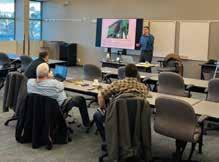
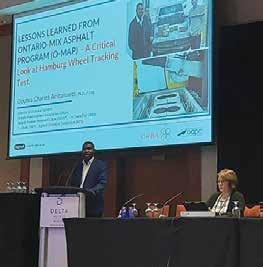
Scan to see all of our events!

APRIL
JUNE
SPRING OPERATION SEMINAR 2.0
11 GOOD ROADS CONFERENCE APRIL 21 – 24 Visit ORBA/OAPC Booth 304 ASPHALT TECHNICAL SYMPOSIUM
11 – By invitation only — email doubra.ambaiowei@orba.org for participation inquiries AMO CONFERENCE AUGUST 18 - 21 MEMBERS’ GOLF TOURNAMENT AUGUST 29 OAPC CHAIR’S DINNER NOVEMBER 27 OAPC FALL ASPHALT SEMINAR NOVEMBER 28
Andrew Weltz
SPRING 2024 41
Steve Manolis

THE LAST WORD
Susan L. Tighe
It’s still about relationships 30 years later
I attended my first Ontario Hot Mix Producers Association (OHMPA now OAPC) annual conference in December 1993. At that time, I was an engineer in training in the MTO Materials Engineering Development Program working in the bituminous section. I spent May to October 1993 out in construction and then went into the bituminous section for my winter assignment. I have to admit I do not recall much about that day, but I do remember enjoying myself and I met many people whom I would continue to work with even to this day more than 30 years later.
As I continued to work for the MTO, and move through my assignments, I started a master’s degree at the University of Waterloo part-time in 1995, and then a doctorate full time in 1997 before starting as a professor in 2000 at the University of Waterloo. This was really the point where my involvement with OHMPA/OAPC blossomed.
Although I could write about many exciting collaborations, for me the creation of the Centre for Pavement and Transportation Technology (CPATT) and having OHMPA involved from the ground up was instrumental. It was a time of possibility where we wanted to create the leading Canadian pavement research centre. It was very entrepreneurial in spirit and became a beacon for recruiting the best and brightest students. It meant collaborating with many different stakeholders. It also meant that I would continue to be a regular attendee and often speaker at the annual conference as well as sending many students to attend over the years.
With the creation of CPATT, I had the privilege of leading many research projects which have contributed to the planning, design, construction, maintenance and management of infrastructure in Canada. It’s hard for me to select a
specific stand-out area because we worked on so many interesting and transformational projects. It also meant that I would work on several projects directly with OAPC and many of its members including contractors, suppliers and consultants. But for me, it’s always been about training students who are now well-known leaders in the asphalt industry, not only in Ontario but in Canada and beyond. This is what makes me proudest. Seeing my previous students be successful is what I truly take delight in.
Over the last three decades, I have seen firsthand many changes in the industry. It has continued to be progressive in sustainability, usage of materials, application of innovative designs, and recycling, to name a few. It is encouraging for me to read ASPHALTopics and see how the industry continues to strive for excellence. I am also encouraged that there are continued opportunities to have publicprivate-academic partnerships to advance state-of-the-art-practice. I think this has been very successful over the years.
In closing, I am very grateful to have been part of this industry for more than three decades. Although I spend less time doing research, I still supervise students because this is my joy. I look forward to continuing to contribute to this industry and know that there are many great advances to come.
Susan L. Tighe, Ph.D., P.Eng. is Provost and Vice-President (Academic) and professor of civil engineering at McMaster University.
42 OAPC | ASPHALTOPICS
















 by Mate Jurkin
by Mate Jurkin










































 by Jon Anderson
by Jon Anderson















 by Steve Pecar
by Steve Pecar












 GOLD SPONSORS
SILVER SPONSORS
BRONZE SPONSORS
GOLD SPONSORS
SILVER SPONSORS
BRONZE SPONSORS








